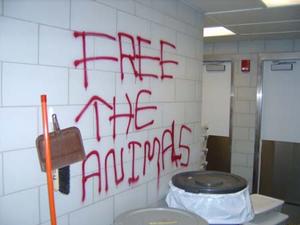Animal-rights terrorismGrowing menace: animal-rights terrorism
The phenomenon of increased violence committed by some extremists in the name of animal rights is a growing cause for concern. In a major conference organized by Europol and Eurojust, fifty-eight experts from law enforcement and prosecution authorities, plus representatives from thirty-five private sector organizations, met last week at Europol’s new headquarters in The Hague to discuss the issues behind this new trend

Expectation is for more extreme action than spray paint // Source: change.org
The phenomenon of increased violence committed by some extremists in the name of animal rights is a growing cause for concern. In a major conference organized by Europol and Eurojust, fifty-eight experts from law enforcement and prosecution authorities, plus representatives from thirty-five private sector organizations, met last week at Europol’s new headquarters in The Hague to discuss the issues behind this new trend.
Europol says that while the defense of the rights of animals and their welfare is legitimate and fully supported by European Union institutions, the increase in violence by extremists remains a concern for all of the conference participants. An example is the increased use of Improvised Explosive Devices (IEDs) and Improvised Incendiary Devices (IIDs).
Violent animal rights extremists do not hesitate in sending threatening e-mails or making warning phone calls to their targets, often intimidating their family and committing physical assaults on their property, in so-called home visits. This has resulted in arson attacks on cars and property.
Single-issue extremist groups are also actively targeting the fur and pharmaceutical industries. This has included the mass release of animals and the destruction of feeding and water installations for the animals. Another tendency is that single-issue extremist groups (including anarchist groups) are supporting each others’ causes more and more.
“The conference at Europol’s new headquarters was an important milestone in these efforts.” says Rob Wainwright, director of Europol.
Together with a tactical meeting held at Eurojust in April 2011 on the same topic, the conference clearly identified the need for a wider exchange of information to provide the member states’ authorities with a clear picture of ongoing criminal activities. There is a tendency to underestimate the importance of the phenomenon and of the links between criminal actions committed in different countries. Forensic analysis clearly demonstrates that some attacks committed in the EU have used the same modus operandi and that the devices used are similarly manufactured.
From the discussions at the conference, it became obvious that the violent criminal activities are often orchestrated at an international level. To this end, speakers said there was a need for increased law enforcement coordination at an international level, as well as more awareness on a local police and judicial level.
The conference recommendations include:
- Encouraging member states’ authorities to prevent and fight all forms of violent criminal extremism and developing, at an EU level, a renewed dialogue on animal protection and animal welfare to allow all concerned parties to express their needs and concerns in a democratic way
- Exploring the possibility of sharing technical data with the relevant parts of the corporate security community and their branch organizations, respecting the data protection regulations within Europol and Eurojust’s existing legal frameworks
- Developing a common strategy with the corporate security community to further cooperation between EU institutions and the relevant parts of the private sector.
The above recommendations were supported by a conclusion that called for increased information exchange with Europol and Eurojust on attacks, prosecutions and convictions in animal rights extremism cases. This will lead to the identification of good practice, increased sharing of experience and ultimately a more efficient and coordinated approach in tackling the phenomenon.
